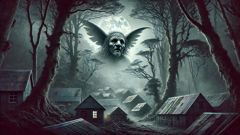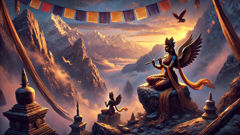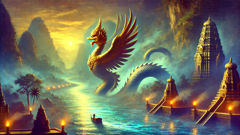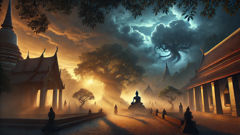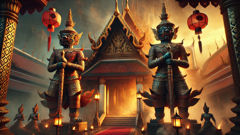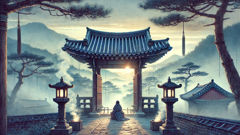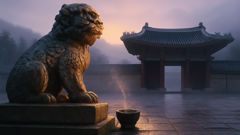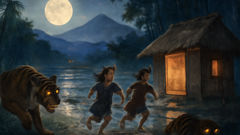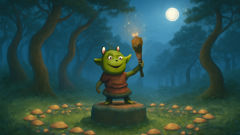Introduction
In the far south of Chile, where emerald forests stretch beneath the watchful gaze of snow-capped volcanoes and mist drifts through ancient valleys, tales are woven as tightly as the branches of the towering alerce trees. The Mapuche people, whose connection to the land runs deeper than the roots of the oldest coihue, have passed their stories down from one generation to the next, stories that breathe with the pulse of the earth itself. Among these, one legend stirs the air with a peculiar chill—a legend that travels on the wind at night, unsettling livestock, setting children to tremble, and causing even the bravest to glance over their shoulders when the moon is thin. This is the legend of the Chonchon, a creature born not merely of fear, but of a complex dance between power, ambition, and the unyielding spirit of a community bound together by hope.
To the Mapuche, the Chonchon is more than a story to frighten the young. It is a warning, a reminder of the dark corners of human desire and the mysterious energies that flow through their world. The Chonchon, they say, is the transformed head of a kalku—a sorcerer who has mastered ancient secrets and chosen a path apart from the healers, the machi. By night, with the aid of forbidden magic, the kalku detaches their own head, sprouting enormous feathered ears that beat like wings, launching into the night as a grotesque, floating apparition. Its cry—"Tué, tué, tué"—echoes through the valleys, an omen of death or misfortune. No one who hears it sleeps soundly; doors are barred, windows sealed, and prayers whispered until dawn.
But not all stories end in darkness. In a time not so long ago, when the forests whispered more loudly and the balance between old ways and new was shifting, one Mapuche village found itself caught in the shadow of the Chonchon. Out of fear and necessity, courage was forged, and a new chapter was written in the ancient lore. This is that story—a tale of fear and faith, of a young woman’s resolve, and of a community discovering that sometimes, to face a monster, one must first remember the strength of light.
The Village in the Shadow of Wings
In the heart of Mapuche territory, nestled between the green velvet hills and winding rivers, the village of Kutralcura thrived quietly, its people tending to their crops, weaving their tales, and honoring the spirits of earth and sky. The air here always carried the scent of wood smoke and wet earth; the songs of birds greeted the rising sun, and children’s laughter chased through the narrow paths between reed-thatched homes. Yet beneath the surface peace, a lingering anxiety had begun to ripple across the village.
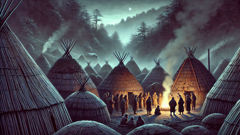
For weeks, rumors had traveled faster than the streams. Sheep had gone missing, their bloodless bodies discovered at dawn, eyes staring up in terror. Chickens refused to roost, dogs whimpered at invisible threats, and the old machi, Yancul, began to speak of omens. It started with one frightened boy’s report: he’d heard a strange, fluttering sound above his home in the night, followed by the dreadful cry—"Tué, tué, tué." Soon, others whispered that they too had heard it, always on nights when the moon was a thin sickle in the sky.
María Antumalen was not one to frighten easily. The daughter of the village’s carpintero, she was clever with her hands and quick of mind, known for her stubborn streak and her sharp, searching eyes. Her mother had died young; her father, now graying but still strong, raised her with a quiet pride, teaching her the old songs and the secrets of wood and water. María had always felt the pull of the world’s mysteries, but she’d never expected to find herself at the center of one.
On a night when the clouds pressed low and the wind was restless, María awoke to a sound like the flapping of enormous wings. Heart pounding, she crept to the window. There, silhouetted against a slice of moon, floated a thing that defied reason—a severed head, crowned with wild hair and glistening eyes, with two enormous, feathered ears beating the air. Its lips moved in a silent curse. As if sensing her gaze, the Chonchon turned its head and fixed her with a look so cold it burned. María ducked away, trembling, clutching a talisman her grandmother had woven for protection.
The next morning, the village buzzed with fear. An elder had fallen ill, and a child woke screaming from a nightmare she couldn’t describe. The machi called a meeting in the ceremonial ruka. Smoke from sacred herbs curled through the thatch, and the people gathered close, desperate for reassurance. Yancul’s eyes were grave as she spoke: "The Chonchon brings sickness and misfortune. It feeds on fear. But there are ways to resist its power, if our hearts are steady and our minds clear."
For María, the encounter had left a mark deeper than fear. She wanted answers—about the creature, about why it had singled her out, about the strange sense of familiarity she felt when its gaze met hers. She sought out Yancul, who received her with solemn kindness. “There are kalkus among us," Yancul confided. "Those who choose the path of darkness, who envy and covet. The Chonchon is a mask for what lies beneath—a heart twisted by hate. But every mask can be unmade. You must be strong, child. The spirit world is closer than you think."
That night, María sat awake by her window, talisman in hand, watching the stars flicker above the restless trees. She felt the weight of her ancestors behind her, and a resolve began to grow: she would not let the Chonchon terrorize her home. She would seek its source, unmask its secret, and reclaim peace for her people.
The Hunt for Shadows
The following days were marked by unease and secrecy. Even in daylight, the people of Kutralcura cast wary glances skyward, and conversations stopped abruptly whenever an unfamiliar face approached. María sensed that fear was fracturing her community, making neighbors into strangers. She resolved to act.
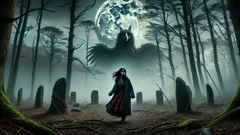
She began her investigation quietly, asking gentle questions as she helped with weaving or fetched water from the river. The elders remembered stories from their own youth—a jealous brother who vanished after a neighbor fell ill, a midwife whose eyes seemed too sharp at dusk. María took note of those who kept to themselves, who refused to meet her gaze when talk turned to omens and sorcery.
Her closest friend, Lihuen, a weaver with laughter like chimes, joined her quest. "You’re braver than you know," Lihuen whispered. Together, they visited Yancul again, who revealed more of the old ways: “The kalku draws strength from secrecy and night. But symbols—woven with care, blessed by spirit—can weaken its hold. And the Chonchon cannot enter a home where kindness reigns."
That night, María stayed awake with Lihuen, weaving new talismans with silver thread and seeds from sacred trees. They hung them above their doors and gave them to neighbors, explaining their purpose as best they could. Some villagers were skeptical, but desperation made them willing to try.
On the third night, the wind carried the cry again: "Tué, tué, tué." María’s father woke gasping for breath, his skin clammy. Lihuen’s dog howled and refused to enter the house. María slipped outside, talisman clutched tight. The moon was hidden behind racing clouds, but she saw movement in the shadows at the forest’s edge—a flicker of white hair, a glint of eye.
She followed. Branches snagged at her skirt as she pushed into the trees. The air was thick with mist and the scent of damp moss. The Chonchon appeared ahead, hovering above a circle of stones where ancient rituals were once performed. Its head twisted in the air, its tongue flicked out, tasting the wind. María’s heart hammered, but she remembered Yancul’s words: “Show no fear. Speak its name.”
Summoning every ounce of courage, María called out: "Chonchon! You have no power here! Return to your flesh or be unmasked!"
For a moment, the creature faltered. The wings slowed. The face—twisted and grotesque—writhed as if in pain. Then, with a screech, it darted into the trees, vanishing into the night.
The next day, María confided in Yancul. The machi’s face was pale, but her voice was strong: “You have wounded it. It is weakest when confronted with truth. But it will return, angrier than before.”
The village prepared as best they could. Talismans were woven for every home. Stories were shared openly; suspicions aired, grudges confessed. By facing their fears together, the villagers drew closer, their bonds growing stronger in defiance of the darkness.
The Night of Truth
The fear gripping Kutralcura reached its peak on a night when the wind was fierce and even the bravest animals refused to leave their shelters. It was then that María realized the Chonchon’s attacks were not random. Each visit coincided with moments of conflict or bitterness in the village—an angry quarrel between cousins, jealousy over a new marriage, old wounds reopened. The Chonchon fed on discord as much as it thrived in darkness.
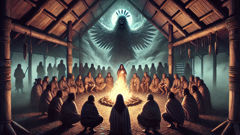
María gathered the villagers in Yancul’s ruka by firelight. She spoke openly of her encounter in the forest and shared what she’d learned. "This creature is born of our own shadows—of secrets, envy, and unspoken wrongs. We must face what we have hidden from one another. Only then can we hope to drive it away."
It was a difficult gathering. Tears were shed as old grievances were brought into the open. Two brothers who hadn’t spoken in years embraced. A widow forgave her neighbor for a long-ago slight. As the flames danced and smoke curled upward, María felt a change in the air—a loosening, as if the village itself was exhaling after a long tension.
But as midnight approached, a sudden chill swept through the ruka. The wind howled, and the fire guttered. Outside, the dreadful cry sounded—louder and closer than ever: "Tué, tué, tué!"
The villagers clung to each other in terror as the Chonchon appeared outside, hovering above the ceremonial circle. Its eyes glowed with malice; its wings beat so hard that leaves swirled in a miniature storm. María stepped forward, talisman raised, voice clear: "Chonchon! You are not welcome here. We see you for what you are—a servant of hate and fear. You cannot thrive where we stand together in truth and kindness."
The creature screamed—a sound so piercing it seemed to shake the very bones of the village. But as María spoke, others joined in, repeating her words. The Chonchon’s form flickered and twisted; its wings faltered. The machi Yancul began a chant in the old tongue, calling on ancestors and spirits of light.
A brilliant glow spread from the fire, engulfing María and then the whole crowd. The Chonchon shrieked one last time—then with a rush of wind and feathers, it burst apart in a cloud of black smoke. When the mist cleared, only silence remained. The villagers stood together, trembling but unharmed. The darkness had lifted.
Conclusion
When dawn broke over Kutralcura, it found the village transformed—not just by relief, but by a renewed sense of unity and purpose. The terror that had haunted their nights was gone, but its lessons lingered. The elders reminded the young that darkness takes root where suspicion and resentment fester, but is banished by honesty and compassion. María became a symbol of hope, her bravery woven into new songs and stories, her name whispered with gratitude beside the fire.
And though some claimed they still heard faint echoes of "Tué, tué" on distant winds, no one saw the Chonchon again. With each telling of the tale, its power diminished, replaced by a deeper understanding of both fear and courage. For in facing the unknown—be it a monster in the night or a secret in one’s heart—the Mapuche people discovered that true strength comes from standing together in light.

